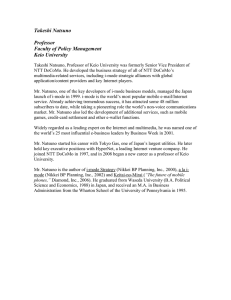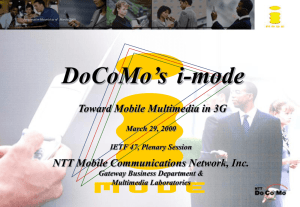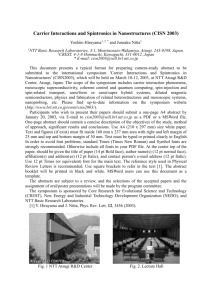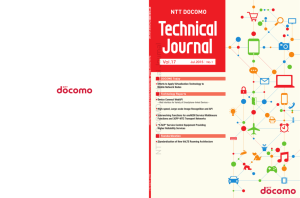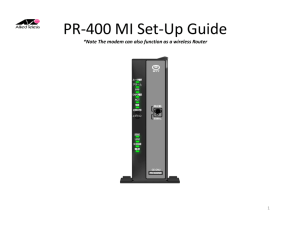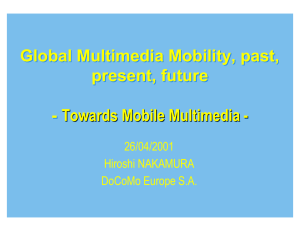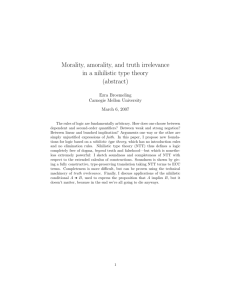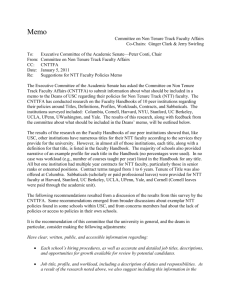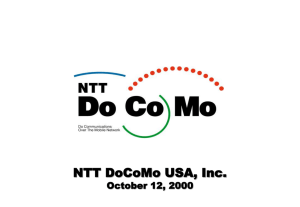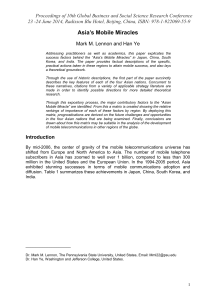Company Overview
advertisement
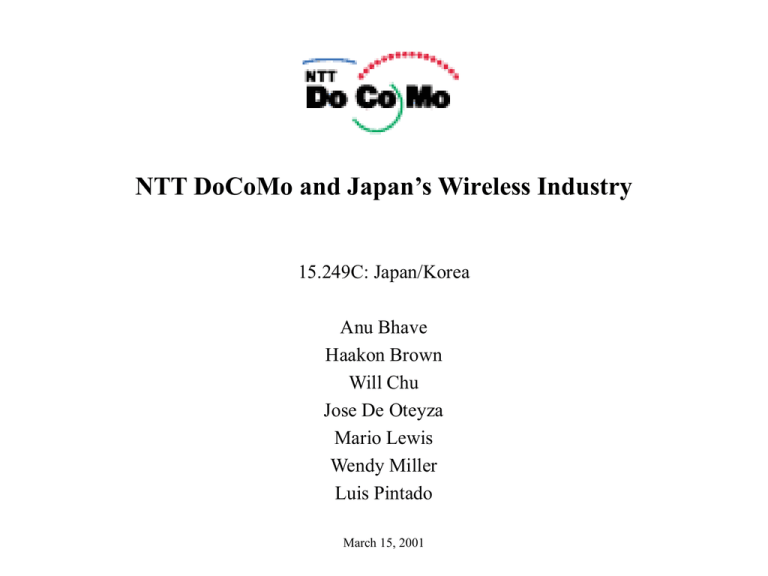
NTT DoCoMo and Japan’s Wireless Industry 15.249C: Japan/Korea Anu Bhave Haakon Brown Will Chu Jose De Oteyza Mario Lewis Wendy Miller Luis Pintado March 15, 2001 Agenda Introduction NTT DoCoMo • Company Overview • Organizational Overview • Product & Service Overview • Industry Overview • Strategy Overview • Current Challenges • Questions to Ask Conclusions March 15, 2001 2 Company Overview Major Lines of Business • Mobile voice, PDC cellular phones: 34,218,000 subscribers (12/31/00) • Mobile data, i-mode: 20,468,000 subscribers (3/11/01) Ancient History • 1987 Mobile telephone service offered by NTT • 1991 Provisional parent company established Subsidiaries established in 8 regions • 1992 Renamed NTT Mobile Communications Network, Inc. Takes over all of NTT's mobile operations March 15, 2001 3 Company Overview (cont’d) Current Facts and Figures • Japan’s largest mobile communications firm 2nd largest firm worldwide (behind Vodafone AirTouch) 57%+ market share but penetration rate flat 1.75% “churn” rate (extremely low) • i-mode service introduced in 1999 and is hugely successful 20,468,000 total users Avg new subscriber rate = +750,000/month = +25,000/day = +1,000/hr • i-mode on pace to pass AOL and become the world’s largest ISP March 15, 2001 4 Company Overview (cont’d) Financial and Operational Highlights • 67% owned by NTT • IPO 1998; traded on NYSE, ticker NTDMY (ADR) • Market Capitalization: ~$160 billion, P/E 65 (March 2001) • 15,000 employees • 2000 Revenues: ~$32 billion • 96% of revenue from mobile phone service • Over the past three years EBITDA grew at 22% • EBITDA to sales ratio of 38% Comparables: Vodafone Airtouch (33%) and AT&T Wireless (16%) March 15, 2001 5 Organizational Overview Typical Japanese company? • Intricate relationship with sub’s March 15, 2001 • Heavy organizational structure 6 Product & Service Overview i-mode (information-mode) • Mobile voice and data services • 99% coverage within Japan (8 regions) • Monthly fee + data usage charge • 25+ i-mode compatible phones (OEM) Advanced phones (256-color displays) • E-mail (¥1 to ¥10/message) • Aggregated transaction services • Information portal • Internet access March 15, 2001 7 Industry Overview General Characteristics of the Industry • Rapid deregulation in each country • Increasing mergers and acquisitions • Entry of various global players into local markets Five Force Analysis • Illustrates drivers of profitability • Provides insights into industry dynamics • Helps identify key success factors for NTT DoCoMo March 15, 2001 8 Industry Overview (cont’d) Intensity of Competition: High • Emergence of international players • Fight fiercely to defend their large specific assets • Difficult to differentiate Supplier Power: Moderate • Handset Manufacturers – Low (Philips, Sony) • Infrastructure Providers – High (Motorola, Ericsson) • Technology Developers – Moderate (Qualcomm) Buyer Power: Low • Very fragmented • But low switching costs March 15, 2001 9 Industry Overview (cont’d) Threat of Substitution: Low • Any kind of communication method Barrier to Entry: Moderate to High • Ownership of wireless spectrum licenses • Excess network capacity Deters new investment Allows for reseller type new entrants (Virgin) Profitable industry, but increasing competition can erode profit margins in the near future Currently DoCoMo is well positioned - dominant status, ownership of key technologies March 15, 2001 10 Strategy Overview (Resources) Core Competencies • Strong management team (Sloan MBA’s in executive positions) • Marketing skills • Investments in R&D and Technology • Relationships with manufacturers • Relationships with content and service providers Resources • Economies of scale • Financial resources • Brand recognition March 15, 2001 11 Strategy Overview (Execution) Internationalization • "Friendly" alliances to enter new markets • Partnerships & Joint Ventures Global Strategy • Sliver global strategy • Expansion of technology (set W-CDMA technology standard) • "Friendly" alliances and acquisitions 42.3% AOL Japan (40.3% owned by AOL) 20% KG Telecom (Taiwan) 16% AT&T Wireless (U.S.A.) 20% Hutchinson 3G (U.K.) 15% KPN Mobile (Europe) 19% Hutchinson Telecom (Hong Kong) 3.6% Telefonica Celular (Brazil) March 15, 2001 12 Current Challenges Major player in the global telecom market • Increased rivalry in wireless industry • Investing in telecom infrastructure • Young and inexperienced player • Implementing an aggressive global strategy March 15, 2001 13 Questions to Ask • What are the management skills required to make the leap from a leading domestic player to a major global player? • Have you thought about seeking a major partner or acquisition to help make the transition to a global player? • What are your growth targets over the next 5 years in terms of revenues, subscribers and market share? • How do intend to finance the build out of worldwide mobile communications infrastructure? March 15, 2001 14
